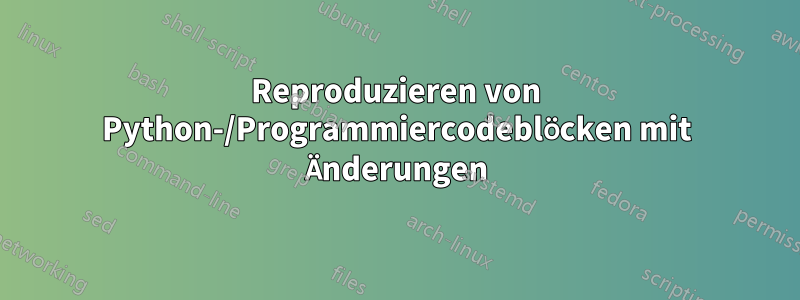
Ich möchte diese Umgebung im Rahmen der Prüfungskorrektur reproduzieren können.
Ein Hinweis, den ich gefunden habe, ist die Verwendung des bclogo-Pakets.
Ich möchte jedoch den hervorgehobenen Python-Code wie hier angezeigt einfügen und Einrückungslinien einfügen und diese entsprechend dem Umfang (Einrückungsebene) einfärben.
Einfärben der Linien eines Algorithmus:
Code des farbigen Algorithmus:
\pdfoutput=1
\usepackage[linesnumbered,titlenumbered,ruled,vlined,resetcount,algosection]{algorithm2e}
\usepackage[usenames,dvipsnames]{xcolor}
\usepackage{color}
\begin{document}
\title{MWE}
\maketitle
\section{Algorithm}
\begin{algorithm}
\caption{3-SAT in polynomial time}
\label{alg:hs}
\DontPrintSemicolon
\KwIn{List of clauses}
\KwOut{The clauses are satisfiable}
\SetKwProg{Fn}{Function}{ is}{end}
\Fn{\textsc{IsSatisfiable}($C$)} {
\color{red} %<- my best attempt
$k\gets 0$ \;
\For {$i = 1$ \bf{to} $|C|$}
{
$c_i \gets $ $i$-th clause \;
$L \gets$ list of literals of $c_i$ \;
$k\gets f(k, L)$ \tcp{a miracle in polynomial time}
}
\color{black} %<- go back to color black
\If {$k$ is even} {
\Return true
}
\Else {
\Return false
}
}
\end{algorithm}
\end{document}
Antwort1
Für den Python-Code gibt es hier eine Lösung mit dem Paket piton, die die Verwendung von LuaLaTeX (aber kein externes Programm) erfordert.
\documentclass{article}
\usepackage{geometry}
\usepackage{tikz}
\usepackage{piton}
\usepackage{lipsum}
\definecolor{bleupyth}{rgb}{0.2157,0.436,0.6172}
\definecolor{jaunpyth}{rgb}{1,0.8157,0.25}
\newcommand{\PythonLogo}{
\begin{tikzpicture}[scale=0.004]
\begin{scope}[,yscale=-1]
\fill[bleupyth] (41.1090,0.0000) .. controls (20.0860,0.0000) and
(21.3980,9.1170) .. (21.3980,9.1170) -- (21.4220,18.5620) --
(41.4840,18.5620) -- (41.4840,21.3980) -- (13.4530,21.3980)
.. controls (13.4530,21.3980) and (0.0000,19.8710)
.. (0.0000,41.0860) .. controls (0.0000,62.3010) and
(11.7420,61.5470) .. (11.7420,61.5470) -- (18.7500,61.5470) --
(18.7500,51.7030) .. controls (18.7500,51.7030) and
(18.3710,39.9610) .. (30.3050,39.9610) .. controls
(42.2380,39.9610) and (50.2030,39.9610) .. (50.2030,39.9610)
.. controls (50.2030,39.9610) and (61.3830,40.1410) ..
(61.3830,29.1560) .. controls (61.3830,18.1720) and
(61.3830,10.9920) .. (61.3830,10.9920) .. controls
(61.3830,10.9920) and (63.0820,0.0000) .. (41.1090,0.0000) --
cycle(30.0470,6.3520) .. controls (32.0430,6.3520) and
(33.6560,7.9650) .. (33.6560,9.9610) .. controls (33.6560,11.9570)
and (32.0430,13.5700) .. (30.0470,13.5700) .. controls
(28.0510,13.5700) and (26.4380,11.9570) .. (26.4380,9.9610)
.. controls (26.4380,7.9650) and (28.0510,6.3520)
.. (30.0470,6.3520) -- cycle;
\end{scope}
\begin{scope}[shift={(81,-81)},xscale=-1]
\fill[jaunpyth] (41.1090,0.0000) .. controls (20.0860,0.0000) and
(21.3980,9.1170) .. (21.3980,9.1170) -- (21.4220,18.5620) --
(41.4840,18.5620) -- (41.4840,21.3980) -- (13.4530,21.3980)
.. controls (13.4530,21.3980) and (0.0000,19.8710)
.. (0.0000,41.0860) .. controls (0.0000,62.3010) and
(11.7420,61.5470) .. (11.7420,61.5470) -- (18.7500,61.5470) --
(18.7500,51.7030) .. controls (18.7500,51.7030) and
(18.3710,39.9610) .. (30.3050,39.9610) .. controls
(42.2380,39.9610) and (50.2030,39.9610) .. (50.2030,39.9610)
.. controls (50.2030,39.9610) and (61.3830,40.1410) ..
(61.3830,29.1560) .. controls (61.3830,18.1720) and
(61.3830,10.9920) .. (61.3830,10.9920) .. controls
(61.3830,10.9920) and (63.0820,0.0000) .. (41.1090,0.0000) --
cycle(30.0470,6.3520) .. controls (32.0430,6.3520) and
(33.6560,7.9650) .. (33.6560,9.9610) .. controls (33.6560,11.9570)
and (32.0430,13.5700) .. (30.0470,13.5700) .. controls
(28.0510,13.5700) and (26.4380,11.9570) .. (26.4380,9.9610)
.. controls (26.4380,7.9650) and (28.0510,6.3520)
.. (30.0470,6.3520) -- cycle;
\end{scope}
\end{tikzpicture}}
\ExplSyntaxOn
\NewPitonEnvironment{Python}{}
{
\noindent \PythonLogo\newline \nobreak
\leavevmode
\hspace* { 7.4 pt }
\vrule width 1pt
\hspace* { 5 pt }
\dim_set:Nn \l_tmpa_dim { \linewidth - 12.4 pt }
\begin { minipage } { \l_tmpa_dim }
}
{ \end { minipage } }
\ExplSyntaxOff
\begin{document}
\lipsum[1]
\begin{Python}
class PCFS(StratégieOrdonnancement):
def elire(sef):
p = min(selp.fp.data, key = lambda p : p.taP)
if p.taP <= self.horlogie:
p.changerEtat("Elu")
\end{Python}
\end{document}
Der Code für das Logo von Python wurde übernommenHier.





